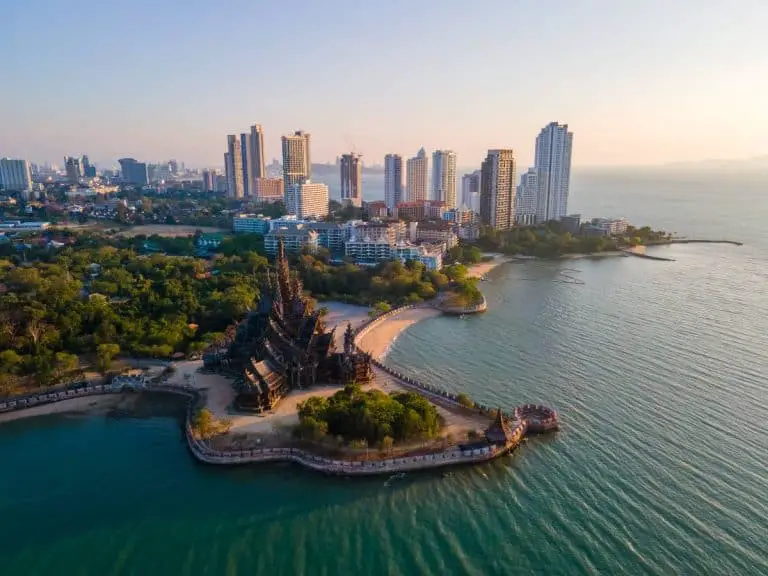The Climate In Thailand (And What To Expect)
Thailand is a country located in Southeast Asia. It has a tropical climate, which means the weather is hot and humid all year long. If you’re planning on traveling to Thailand, or if you’re just curious about what the weather is like there, then this blog post is for you! We’ll discuss the average temperatures and rainfall in Thailand, as well as what to expect during different times of the year.
The majority of Thailand has a subtropical climate, hence the country’s weather is hot and humid all year round. Temperatures commonly exceed 40° C (105° F) during the hottest months of the year. Each day will still reach a high of roughly 30 degrees Celsius (86 degrees Fahrenheit), even in the “rainy” months.
Key Takeaways
- Rainfall varies throughout different parts of the country, but it will still reach an average high of 30 degrees Celsius (86 degrees Fahrenheit) during the “rainy” months.
- Also, consider bringing insect repellent if you plan on spending time outdoors, and be aware that some areas of Thailand are prone to flooding, so it’s important to stay informed about the weather and take precautionary measures if necessary.
- Thailand has a tropical climate with hot and humid temperatures all year long. With the proper planning and precautions, you can enjoy your time in Thailand without worry!

Thailand is one of the most popular tourist destinations in the world. It’s known for its beautiful beaches, friendly people, and delicious food. But before you pack your bags and head to Thailand, make sure you understand the climate there!
When planning your trip, it’s important to know what sort of weather to expect. This guide will give you an overview of Thailand as a popular tourist destination and help you understand the climate so you can make the most of your trip.
Overview of Thailand’s climate
Because of its central location in Southeast Asia, the Kingdom of Thailand is a vital hub for the region. Thailand is the second-largest country in Southeast Asia, with an area of more than 200,000 square miles.
Thailand’s terrain varies from wooded mountains and plateaus to parched highlands and rich river valleys to sandy coastlines and islands. There are mountain ranges all the way from the border with Myanmar to the southernmost tip of Malaysia. North and south, the country is divided by another mountain range.
Unlike most rivers, the Chao Phraya actually starts its journey in the north and ends up in the south. This system of canals, known as klongs, is responsible for bringing water to the Central Plains, where it is used to irrigate the region’s rich rice fields. This large river is the primary waterway for travel across the country’s center region. Only 35 miles south of Bangkok, it flows into the Gulf of Thailand.
Location and topography of Thailand
Because of its central location in Southeast Asia, the Kingdom of Thailand is a vital hub for the region. Thailand is the second-largest country in Southeast Asia, with an area of more than 200,000 square miles. Thailand’s terrain varies from wooded mountains and plateaus to parched highlands and rich river valleys to sandy coastlines and islands.
Traveling in Thailand can be a hassle, but with these 40 essential apps, it can make your life easier! Read it here.
Types of climates found in Thailand
The wet season in Thailand lasts from May to October (and even into November and December in the country’s southern peninsular region), and the dry season runs from November to April. West coasters receive a greater share of the total precipitation.
We observed that the months of March through May are the hottest of the year and that the southwest monsoon is responsible for the majority of the year’s precipitation, with the most rain occurring in the afternoon and on occasion lasting for days.
Weather patterns in Thailand
There are three distinct seasons in Thailand:
Dry season
In much of the country, the dry season begins in November and continues through March or perhaps April or May, making that time of year the best time to visit Thailand. However, the Lower Gulf, which includes the idyllic islands of Ko Samui, Ko Phangan, and Ko Tao, experiences its heaviest rainfall between October and December.
Wet season
During the wet season (reudu fon), the southwest monsoon rains dominate the weather, bringing warm, humid air from the Indian Ocean and producing copious rainfall. On average, it rains around once a day, usually for just a few hours in the afternoon or evening, with the greatest downpours occurring in September and October.
The wet season in Thailand is not the hottest time of the year, but the excessive humidity brought on by the SW monsoon can make it feel that way.
If you’re planning on going surfing along the Thai coast, you should know that the monsoon also brings constant onshore winds, which generate solid breakers.
Cool season
Changes in the prevalent wind directions occur throughout the chilly season (ruedu nao) due to the northeast monsoon. Because of this, the temperature and humidity levels inside your home will be more agreeable. In addition to being relatively dry, this makes the cold season the ideal time to explore most of Thailand.
The west coast of Thailand, including popular tourist destinations like Phuket, Krabi, and the Ko Phi Phi islands, enjoys the calmest Andaman Sea conditions throughout the cooler months.
In contrast, the northeast monsoon brings steady rain along the east coast of Thailand (the gulf coast), with its peak in November. This area is subject to flooding throughout the cool season.
Regional variations in climate
Differences in climate between regions
The seasons in northern and central Thailand are distinct from one another. It doesn’t rain much in this region between November and May when the rainy season often begins. Extreme cold is possible in the north and northeast during the cool season (November–February), and scorching temperatures of up to 40°C are common during the hot season (March–May).
Northern and central Thailand experience the wet season from May to November. During the southwest monsoon, when it is most prevalent, the region receives the highest annual rainfall totals. Showers often last for only an hour or two at most. The heaviest and most persistent downpours of the rainy season typically occur in late August and early September.
Our weather ratings chart shows significant differences in the climatic conditions between northern and central Thailand.
Impact of monsoon season on different regions
Northern Thailand (Chiang Mai, Chiang Rai, Sukhotai) and Northeast Thailand (Bangkok area, Kanchanaburi, Ayutthaya, Lopburi) have slightly contrasting climates from the rest of the country (Isan).
The seasons in northern and central Thailand are distinct from one another. It doesn’t rain much in this region between November and May when the rainy season often begins. Extreme cold is possible in the north and northeast during the cool season (November–February), and scorching temperatures of up to 40°C are common during the hot season (March–May).
Northern and central Thailand experience the wet season from May to November. During the southwest monsoon, when it is most prevalent, the region receives the highest annual rainfall totals. Showers often last for only an hour or two at most. The heaviest and most persistent downpours of the rainy season typically occur in late August and early September.
There are only two seasons in the south of Thailand: the wet and the dry. Both of Southern Thailand’s coasts experience these changes at different times. The southwest monsoon brings rain and sometimes severe storms to the west coast from April to October, while the heaviest downpours on the east coast occur between September and December.
Many people think the west coast is greatest between the months of November and March. In places like Phuket, Krabi, Koh Phi Phi, Khao Lak, Koh Lanta, Ranong, and Koh Phayam, a refreshing breeze keeps the heat at bay during the day. Humidity isn’t as bad as it usually is this time of year because of the breeze.
Humidity increases and temperatures climb from March to May when the prevailing wind dies down. The monsoon season typically begins in April and continues through October. The months of September and October often see the most precipitation. If it rains outside of these times, it may just be a quick, intense downpour in the afternoon.
Due to the influence of the Andaman Sea, the climates of all West Coast locations are remarkably constant. Short-term fluctuations in temperature and weather are possible, but long-term differences are not significant.
What about typhoons?
Thailand is prone to natural disasters, such as typhoons and earthquakes (rare). It’s important to stay informed about weather forecasts and any potential dangers before traveling to Thailand. While you’re there, make sure to keep an eye on the news so you can be prepared if a typhoon or earthquake occurs while you’re there.
How to plan for the weather
Tips for packing and dressing for the weather
Thailand is one of the most popular destinations for travelers in the world, and it’s easy to see why. The beaches are beautiful, the people are friendly, and the food is delicious.
But there’s one thing that travelers often forget to prepare for when they go on vacation: the weather. Thailand is known for its tropical climate, which means that it can get pretty hot and humid during certain times of the year.
So how do you pack for a trip to Thailand? Here are some tips for dressing for the weather in Thailand:
Dress in lightweight, breathable clothing
Thailand is a country that is known for its tropical climate, but it can get humid and hot. If you are going to be in Bangkok or other cities in Thailand, you should dress in lightweight and breathable clothing. This will help you stay cool during the day and comfortable at night when the temperatures start to drop.
Avoid wearing clothing that is too revealing
When you’re planning a trip to Thailand, you’ll want to consider the weather. The climate in Thailand is tropical and humid, so it’s important to dress appropriately.
If you’re planning to go on an adventure in the mountains or at sea, bring a jacket and sunscreen with you. If you’re going to visit museums or other cultural sights, dress as if it were a hot summer day at home—that way, if it gets cold (or wet), you can layer up.
Protecting your skin from the strong tropical sun is crucial. This sunscreen offers high SPF protection and is water-resistant.
Bring protective clothing and an umbrella
The weather in Thailand is often sunny and warm, but there are also parts of the country that experience rain.
It’s important to plan for the weather in Thailand if you’re traveling there for business or pleasure.
Bring protective clothing and an umbrella when you go out at night. It’s good to have a hat, sunglasses, and sunscreen on hand as well.
Options for avoiding extreme weather conditions
It’s always important to plan ahead for your trip, but it can be especially important when you’re traveling to Thailand. The country has a tropical climate, and the weather is generally warm and pleasant. However, there are times of the year when the weather turns hot and humid, or rainy and cool. Here are some tips for how to keep your trip on track no matter what the forecast predicts:
- Bring appropriate clothing. You’ll want to pack a variety of clothes that you can mix and match depending on the weather conditions. Don’t forget about shoes! You’ll want to bring good walking shoes that will keep your feet comfortable during long treks through parks or around town.
- Stay hydrated. In addition to bringing plenty of water bottles (and maybe even some electrolyte tablets), make sure that you’re eating plenty of fruits and vegetables while abroad so that you stay well-hydrated without drinking much liquid at all times.
- Know where the shelter is located. If you need somewhere dry during a rainstorm, look for buildings with roofs or sheltered areas close by. If it’s cold outside, find somewhere warm inside like an indoor shopping mall or restaurant where they serve hot drinks like tea
- Pack light clothing so you can easily layer up or down depending on your environment. You don’t want to overheat or get too cold!
- Invest in a rain jacket or umbrella, depending on what kind of precipitation you’ll encounter in Thailand. It’s important to be prepared for anything!
- Make sure you have plenty of sunscreens and mosquito repellent available at all times. The sun is intense and mosquitos are everywhere, so protect yourself from both by always having enough supplies on hand!
- Invest in indoor/outdoor thermometers that can also measure humidity. This helps monitor temperature and humidity levels, allowing travelers to prepare for varying conditions across Thailand.
Climates in Thailand FAQs
What are the 3 seasons in Thailand?
Since this is the case, the weather in Thailand can be broken down into the mild season (November–February), the hot season (March–April), and the wet season (May–October) (March–May).
What is the hottest month in Thailand?
When it comes to temperature, April is Thailand’s hottest month. Day and night, it can easily reach or exceed 30 degrees Celsius (95 degrees Fahrenheit). In April, the heat in Chiang Mai is worse than in Bangkok.
Does it rain every day in Thailand?
Even while it’s technically the rainy season in Thailand from June to October, that doesn’t imply it rains constantly. Showers in the tropics can be rather intense, although they often don’t last more than 30-40 minutes at a time, and only rarely last an hour.
Does Thailand get cold at night?
There is often a noticeable dip in temperature during the night, and at higher elevations, the temperature might even fall below freezing. From March to June, we experience the summer season, often known as the hot and dry season. At the moment, the typical temperature in Bangkok is around 34 degrees, but it can get up to 40 degrees with a humidity of 75%.
Does it snow in Thailand?
No, Thailand does not have snow. Traveling to Thailand in the winter? Snow? Not going to happen. In the late winter of 1955, there were rumors of snowfall in Thailand. The year that Thailand’s record low temperature was also recorded.
Conclusion
Now that we’ve gone over some of the key points about Thailand’s climate, you should have a better idea of what to expect weather-wise if you plan to travel here. Remember to research and plan for the weather before your trip so that you can pack appropriately and be prepared for whatever Mother Nature throws your way. And if you want even more information about living in Thailand, subscribe to our newsletter today – it’s packed with everything you need to know about life in this beautiful country!






